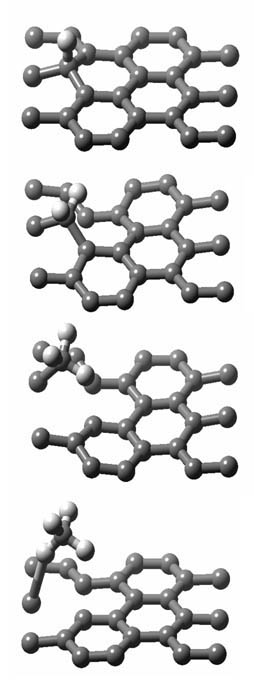For the purpose of exploring microscopic structures and functions of
molecules, crystals and soft condensed matters in the atomic size (1Angstrom),
we adopt quantum mechanical simulation method that relies on the density
functional theory. It describes electrons within atoms and molecules by
their density via the Kohn-Sham equation. This method is thus called ab initio
or first principle molecular dynamics (FPMD)simulations.
We are refining this first principle code to treat atomic
movement and also material deformation through chemical
reactions. This type of the simulation codes is required to
study microscopic behavior of materials at the interface of
high temperature fusion plasmas without making a priori
assumptions, unlike the case of macroscopic transport
codes. (Collaboration with Dr. Y.Zempo).
The left figure shows the FPMD run of hydrogen
atoms adsorbed to the graphite surface. These hydrogen
atoms cut the bonds between carbons at the surface,
make a hydrocarbon atom, which runs away from the
graphite surface. Figure: A sequence of the final states
of graphite surface due to addition of one hydrogen
atom at a time. Gray and white spheres represent
carbon and hydrogen atoms, respectively (calculated
using the Siesta code, developed by ICMAB group,
Spain).
Because of increasing complexity, the Schroedinger
equation, which exactly describes every electrons can be
solved only up to five electrons. However, real material
consists of a huge number of electrons (and nuclei), and
such a system is virtually insolvable even with the fastest
supercomputer. On the other hand, if one treats electrons collectively through
their density instead of wave functions of each electron, the equation becomes
much simpler and solvable (density functional theory). This method is widely
adopted for studies of physical properties and chemical reactions on the atomic
level.
Graphite Erosion by Hydrogen Adsorption
